Discover the elegance and cultural richness of traditional Vietnamese clothing for men, from the iconic áo dài to ceremonial robes worn through centuries of Vietnamese history. Each garment tells a story of heritage, craftsmanship, and social significance that continues to influence modern Vietnamese fashion and cultural celebrations.
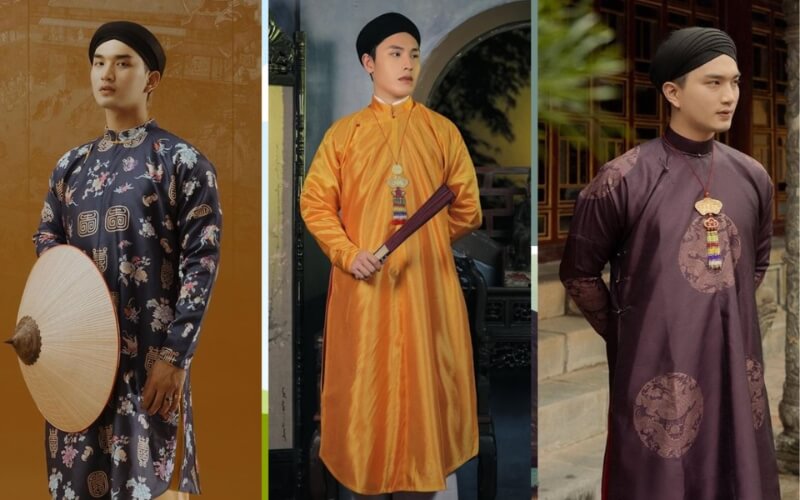
1. Historical Evolution of Vietnamese Male Attire
1.1. Ancient Origins and Chinese Influence (Pre-10th Century)
Vietnamese male attire traces its roots to ancient times, heavily influenced by Chinese culture during periods of domination. The Han dynasty’s structured garments and Confucian aesthetics shaped early Vietnamese clothing, emphasizing simplicity, functionality, and hierarchical symbolism.
1.2. Development Through Dynastic Periods
During the Ly (11th–13th centuries) and Tran dynasties (13th–15th centuries), male clothing began incorporating distinct Vietnamese elements. The áo giao lĩnh (cross-collar robe) was a common style, reflecting a blend of Chinese and native designs. Traditional headwear, such as the khăn vấn (a type of turban), became more prominent.
In the Le dynasty (15th–18th centuries), male attire became more refined, showcasing intricate embroidery and luxurious materials. By the Nguyen dynasty (19th century), the male áo dài emerged, representing a blend of practicality and elegance. The Nguyễn court formalized specific dress codes for different social classes, solidifying traditional styles.
Discover Related Guides: What Should Expat Wear as a Guest at a Wedding in Vietnam?
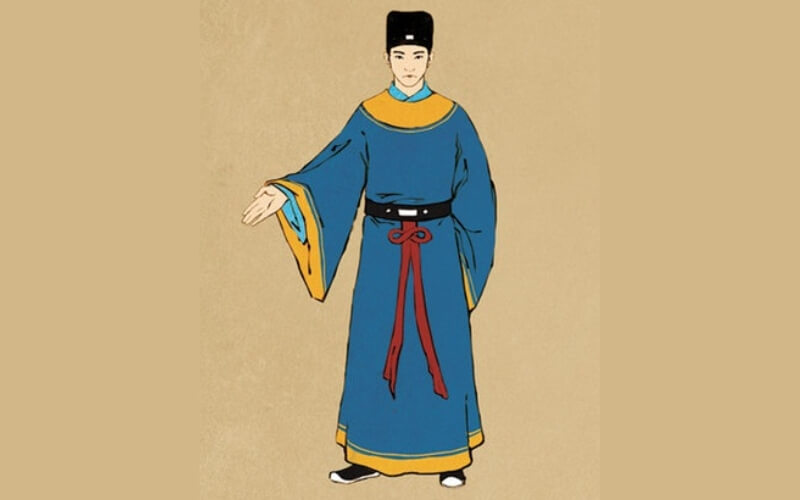
1.3. Regional Variations: North vs. South Traditional Dress
In Northern Vietnam, the áo dài became less popular due to its impracticality for daily work, especially during wartime. The Northern version featured a stiffer collar, lower than the Southern style, and retained more traditional elements with minimal changes in design.
In Southern Vietnam, the áo dài was more influenced by Western fashion, particularly Dior’s “New Look,” with a cinched waist and lighter fabrics suited to the tropical climate. The Southern áo dài also embraced vibrant colors and modern design elements, reflecting a more globalized style.
2. Key Traditional Male Garments
2.1. The Male Áo Dài
The male áo dài typically features a straight, long tunic with slits on the sides, paired with loose-fitting trousers. It emphasizes symmetry and simplicity, often adorned with minimal embroidery.
Ceremonial áo dài are crafted from luxurious fabrics like silk and embellished with gold or silver threads, while daily versions are simpler, made for practicality and comfort.
Contemporary designs incorporate modern fabrics, streamlined silhouettes, and innovative patterns, making the áo dài a versatile garment for modern occasions.
2.2. Traditional Tunics and Robes
- Áo Tràng (Scholar’s Robe): Worn by scholars and officials, the áo tràng symbolizes intellect and status, characterized by its flowing form and somber colors.
- Áo Tứ Thân for Men: While commonly associated with women, the áo tứ thân (four-panel tunic) for men exists in certain rural traditions, often in darker shades.
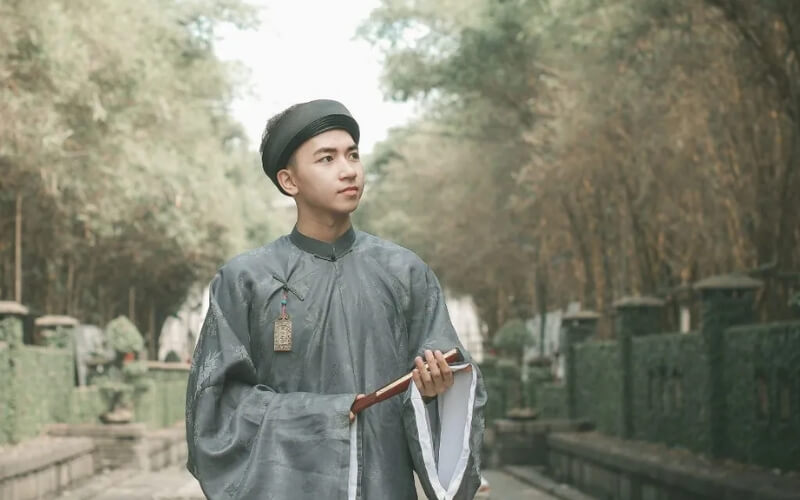
2.3. Traditional Trousers
Quần thụng are iconic traditional trousers in Vietnam, known for their wide, flowing legs that combine elegance with practicality. Made from silk or cotton, they are worn with the áo dài for formal occasions.
While the design is generally consistent, regional variations exist. In the North, trousers are more structured and made from thicker fabrics for colder weather, while in the South, lighter fabrics like linen or silk are preferred for comfort in the hot, humid climate.
Explore More About Vietnam: Durians in Vietnam: The King of Fruits
3. Essential Accessories and Complementary Elements
3.1. Traditional Headwear
- Khăn Đóng (Traditional Turban): The khăn đóng, a type of turban, is one of the most prominent pieces of headwear in Vietnamese male tradition. Worn during formal occasions, it is typically made of black or dark-colored fabric, carefully wrapped around the head in a distinctive manner.
- Nón Lá (Conical Hat) in Male Dress: While often associated with women, the nón lá (conical hat) is also a traditional headpiece worn by men, particularly in rural areas. The nón lá is crafted from palm leaves and bamboo, offering protection from the sun and rain. In the past, it was worn by farmers, fishermen, and laborers, but over time it has come to represent Vietnamese identity as a whole.
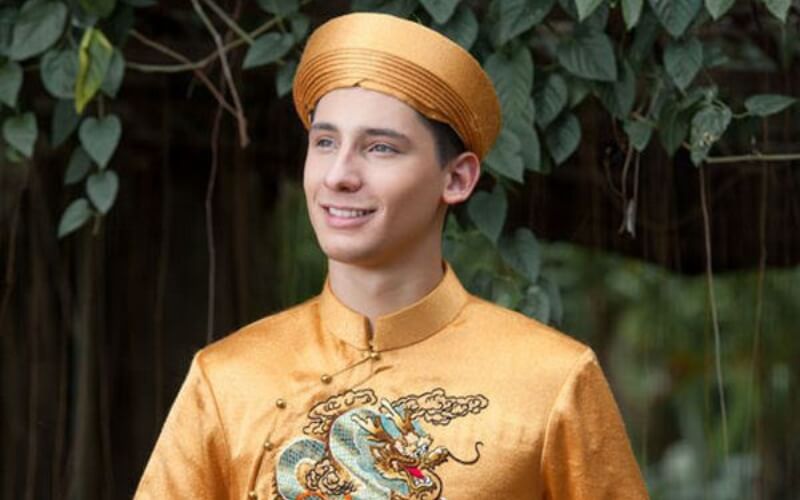
3.2. Footwear and Belts
- Footwear: The most common footwear for men includes guốc (wooden clogs) and giày (traditional shoes). Guốc are wooden sandals, often worn with traditional attire, providing stability and comfort, especially in rural areas, with a raised platform to protect the feet from dirt and water. Giày, made from fabric or leather, are simpler shoes suitable for everyday wear or formal settings, offering a more refined appearance.
- Belts: Belts, typically made of silk, leather, or cloth, serve both practical and decorative functions in traditional attire. Silk belts are worn for formal occasions, often featuring intricate patterns or embroidery, while cloth belts are more common for daily wear, securing trousers (quần thụng) and offering comfort and ease of movement.
3.3. Ceremonial Accessories
Ceremonial accessories in traditional Vietnamese male attire enhance the cultural significance of formal events.
- Ngọc Bội (Jade Brooches): These intricately carved jade brooches are often worn on the chest or attached to the collar of the áo dài. They symbolize nobility, wisdom, and protection. The ngọc bội is considered a symbol of high social status and is commonly seen in royal or scholarly attire.
- Fan (Quạt): is commonly carried as a general accessory, adding elegance and refinement to the outfit. Though not tied to specific events, the quạt enhances the overall appearance of traditional attire, embodying grace and sophistication.
4. Cultural Significance and Symbolism
- Social Status Indicators: Clothing details, like fabric quality and accessories, indicated the wearer’s social rank. Higher-ranking individuals wore more elaborate designs to signify their status.
- Color Symbolism in Male Clothing: Colors had specific meanings—red symbolized prosperity, black represented formality and wisdom, and white was associated with purity and mourning.
- Ceremonial and Festival Attire: Traditional clothing was worn during important events like weddings and festivals to honor cultural customs and celebrate milestones.
- Professional and Scholar Dress Codes: Attire like the áo dài and áo tràng signified one’s role in society, especially among scholars and officials, reflecting intellectual and moral values.
Continue Learning: How Long Does It Take To Learn Vietnamese
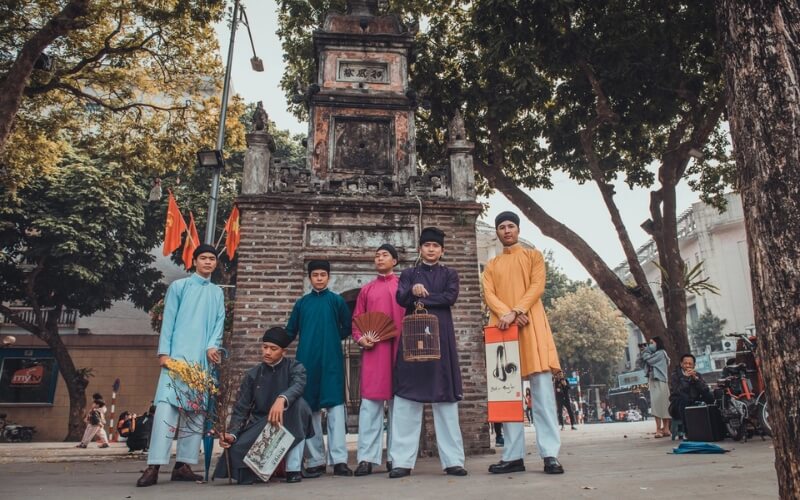
5. Contemporary Relevance and Preservation
Traditional Vietnamese male attire remains relevant today, adapting to modern fashion while preserving cultural significance. The áo dài and other garments have been updated with new fabrics and designs, making them more comfortable and accessible for daily wear while retaining their traditional essence.
As modern adaptations continue, traditional clothing is expected to remain a vital part of Vietnam’s cultural heritage, especially with a focus on sustainability and locally made garments.
6. Practical Guide for Modern Wear
- Choosing Appropriate Styles: When selecting traditional attire, consider the occasion. The áo dài is perfect for formal events like weddings or Tet, while more casual options like áo tràng or quần thụng can be worn for daily use or informal gatherings.
- Proper Wearing Techniques: For garments like the áo dài, ensure it fits well, with the hemline grazing the floor and the sleeves tailored to your arm length. For trousers like quần thụng, make sure they are comfortable and allow ease of movement without being too loose or too tight.
- Care and Maintenance: Traditional clothing often requires delicate care. Hand wash or dry clean garments made from silk or fine fabrics. Avoid harsh detergents and store them in a cool, dry place to preserve their quality.
- Where to Purchase Authentic Pieces: To ensure authenticity, purchase traditional garments from reputable tailors or stores that specialize in Vietnamese clothing. Look for those using high-quality materials and craftsmanship to maintain the cultural integrity of the attire.
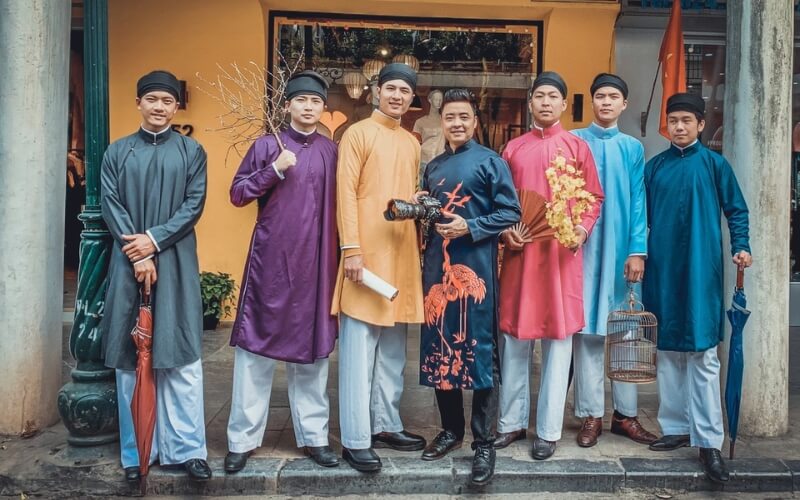
Frequently Asked Questions
1. What is Vietnam traditional clothing called?
Vietnam’s traditional clothing is called the áo dài. It is a long, flowing tunic worn over trousers, typically made of silk or other fine fabrics. The áo dài is known for its elegant design and is worn by both men and women, with variations in style for each gender. It is commonly worn during special occasions, such as weddings, festivals, and cultural events.
2. What are the main differences between Northern and Southern Vietnamese male traditional clothing, and how did these regional variations develop?
The main differences between Northern and Southern Vietnamese male traditional clothing are seen in the design of the áo dài.
- Northern Vietnam: The áo dài has a simpler design with a stiffer collar and less form-fitting waist, reflecting practicality and the hardships during wartime.
- Southern Vietnam: The áo dài features a higher, curved collar influenced by Hong Kong fashion, with a more cinched waist, reflecting Western influences like Dior’s New Look. The Southern version is also more colorful and decorative.
These variations developed due to different historical, cultural, and geographical influences in the North and South.
Traditional Vietnamese clothing for males is not just about fashion; it’s a reflection of Vietnam’s deep cultural roots and historical evolution. Whether it’s the elegant áo dài or the simple áo tràng, these garments tell the story of Vietnam’s past and continue to influence modern fashion. Understanding and appreciating these traditional outfits helps preserve a unique part of Vietnamese heritage.






